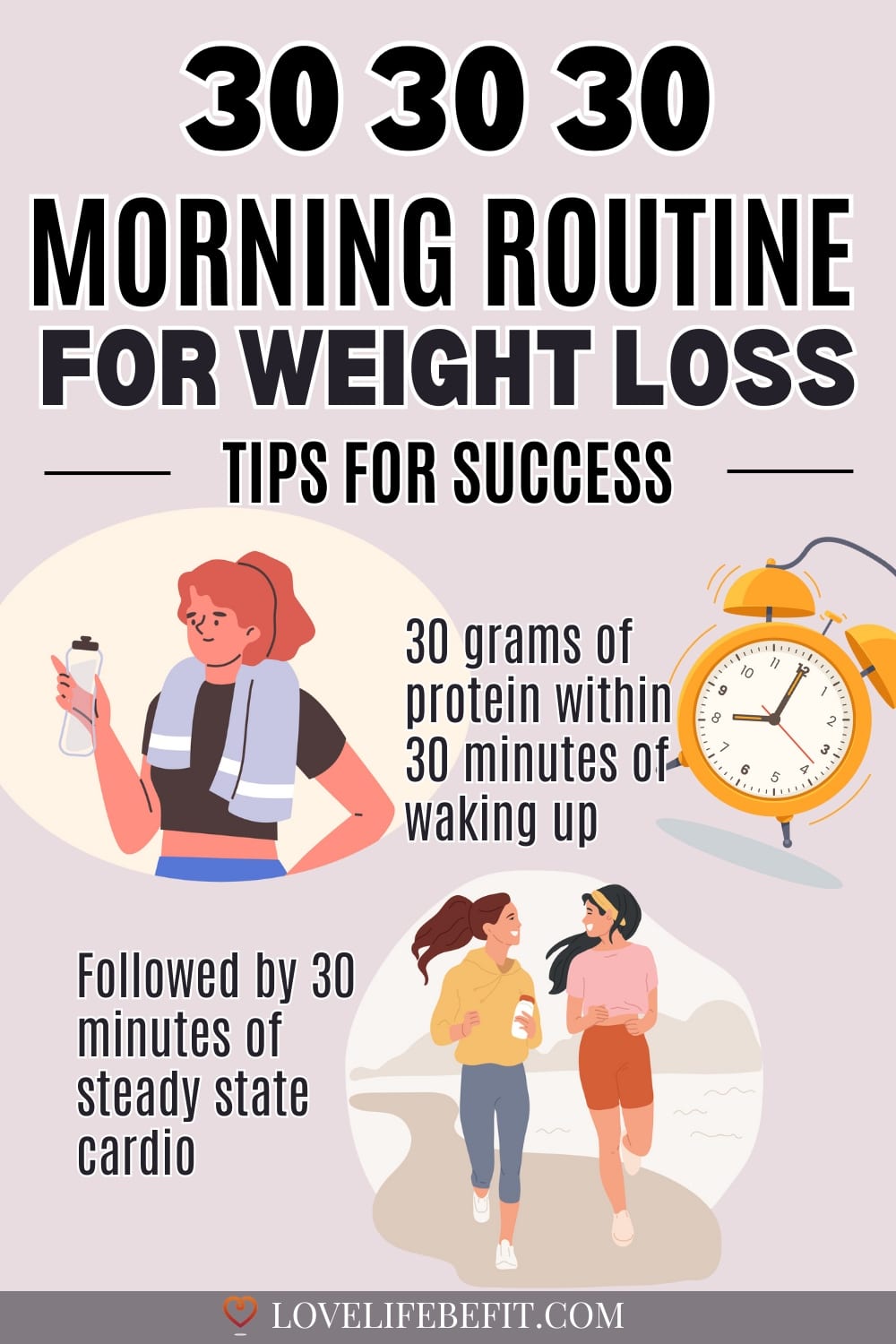30-30-30 Morning Workout Routine For Weight Loss
We all aim to be healthy, but most morning routines can be difficult to sustain. They may be too complicated, too arduous, or involve getting up at the crack of dawn. This is how the 30-30-30 Morning Routine excels. It’s a simple workout routine and accessible to just about everyone. All you have to do is eat some protein when you wake up in the morning, then go for a 30-minute walk. What could be easier? Here are the details…

What Is The 30 30 30 Method For Weight Loss?
This morning routine is designed to help you lose weight. The two easy steps are:
- Eat 30 grams of protein within 30 minutes of waking up.
- Follow with 30 minutes of steady-state cardio exercise.
This 30 30 30 Method is based on Tim Ferriss’s 30 in 30 rule as part of his Slow Carb Diet and became a viral phenomenon under the marketing machine of lifestyle guru Gary Brecka. It’s a non-diet approach to weight loss, and all you have to do is make time for breakfast and fit in 30 minutes of easy exercise. A simple lifestyle change to transform your body!

How Does The 30 30 30 Method Work?
The method does have some solid ideas:
30 grams of protein
Protein maintains muscle mass, helps with satiety after eating, and sustains energy and blood sugar balance. Eating enough protein when trying to lose weight is essential. Guidelines for protein intake are a modest 0.8 grams per kilogram of body weight, but athletes will often need more. 1.0 to 1.2 grams of protein per kilogram of body weight is a typical target if you exercise regularly.
30 grams of protein is a big chunk of your daily needs and gets your day off to a good start. Unlike sugary, carb-loaded cereal, a substantial protein-based breakfast will balance your blood sugar levels and keep you full until lunchtime.
Within 30 minutes of waking up
Up to 30% of adults in the US (and the UK) skip breakfast, and the popularity of intermittent fasting contributes to these numbers. While fasting may work for some people, it can often make you agitated and irritable. When your mood is low, there’s little defence against eating tempting high-fat, high-sugar mid-morning snacks.
Followed by 30 minutes of steady-state cardio exercise
Moving more will always be good for you, but often, if we leave exercise until later in the day, it gets pushed down the priority list. It may feel counterintuitive to exercise straight after eating, but low-intensity exercise is good for digestion and helps with your blood sugar balance.
With low-intensity steady-state cardio exercise, the aim is to keep your heart rate between 60% and 70% of your maximum heart rate. This is often called Zone 2 cardio. It’s training in the fat-burning zone, where most calories burned will come from body fat.
You don’t need a heart-rate monitor to check you’re exercising at the right level. You should be making an effort for steady-state cardio, but still be able to talk. You’re pushing too hard if you’re out of breath and struggling to keep going.
Examples of steady-state cardio depend on your fitness level. For some, it’s a brisk walk; for others, it’s an easy run. Swimming, rowing, cycling, and elliptical are all potential forms of steady-state cardio.
One of the best things about Zone 2 cardio is that it’s not too taxing on the body. A fast-paced 30-minute run can be challenging to maintain day after day, but most people can manage a daily 30-minute walk.
Breakfast Ideas with 30 Grams of Protein
Getting your protein requirement will take some planning. It’s more than just a couple of eggs for breakfast. 2 eggs will provide just 12 grams, so you’ll need to get creative to hit the 30-gram level.
Here are some suggestions:
- Yogurt smoothie made with 1.5 cups of Greek yogurt and blended with banana and a little nut butter. If you enjoy a green smoothie, add some spinach.
- Overnight oats made with cottage cheese, such as this recipe for Raspberry Cheesecake Overnight Oats.
- Tofu Scramble: Add some black beans for extra protein.
- Egg and lentil hash: Mash cooked lentils and some roasted vegetables with two or three eggs and saute.
- 2 cups of baked beans on wholemeal toast.
Tips For A Successful 30 30 30 Morning Routine
30-30-30 is a simple morning routine and workout, but you may still hit some pitfalls. These tips will make it easier to stay on track.
1. Meal Prep Your Breakfast
Making the right breakfast choices is always easier if you meal prep the night before. Not everyone has time to cook in the morning, so a yogurt smoothie, high-protein overnight oats, or a dish you can quickly reheat in a microwave, such as scrambled tofu, will help you hit your 30-gram protein target.
2. Don’t Get Hung Up On the Numbers
Thirty grams of protein is a target. You may find that 20 grams of protein works just as well as if you eat adequate extra protein throughout the day. Eating protein first thing in the morning helps regulate your blood sugar and helps with satiety, but some people may not need the full 30 grams.
3. Have A Liquid Breakfast
If you struggle to eat breakfast, you can consume your protein in liquid form. Whip up a protein shake: Add some protein powder to your favorite smoothie recipe.
4. Lay Your Kit Out The Night Before
For a brisk walk, you don’t need any special clothing, just a supportive bra, comfortable clothing you can move in, and some walking shoes or trainers. Yet it still helps to lay out your kit before you go to bed. When it’s lying there ready and waiting, there’s really no excuse not to exercise!
5. Don’t Sabotage Your Efforts
The 30 30 30 morning routine will only work if you use it as part of your weight loss efforts. If you spend the rest of the day making poor food choices, you will sabotage your efforts. For Tim Ferriss, the 30 in 30 rule was part of a strict eating regimen of whole foods, with no bread, pasta, rice, potatoes, or grains, and no fruit.
I’m not suggesting you need to go to this extreme to lose weight. What works for you depends on your weight loss goals and activity level. For example, endurance runners need carbohydrates for energy, and not everyone is suited to a low-carb diet.
But if you start the day with a healthy breakfast and a good dose of exercise, it’s not an excuse to spend the rest of the day eating donuts and other sugary, high-fat treats. Not if your goal is weight loss.
Thoughts From LoveLifeBeFit
Unlike some weight loss routines, the 30 30 30 morning workout has many benefits. It’s a great way to get moving in the morning if you rarely exercise, and eating sufficient protein helps maintain your muscles and is good for satiety.
For best results, add some extra exercise sessions to your training week. Strength training using bodyweight exercises or visiting a gym will build muscle strength, and one or two more intense cardio sessions a week, such as walking up hills or tempo runs, will challenge your body.






